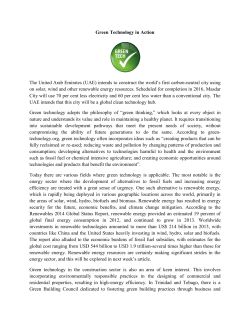
Noureddine BOUTARFA President Sonelgaz / Algeria
Intercontinental Wind Power Congress Istanbul march 31th – 2nd April 2015 Renewable Energy Prospects case of Algeria Noureddine Boutarfa Chairman &CEO Sonelgaz (Algeria) Algeria in brief (1/2) Anticipation on energy needs to support social and economic development is a fundamental issue , to insure and forsee the offer. 2,4 millions km² A population of 40 millions, Electrification rate of 99% Natural gas pipe penetration rate of 53%, 8 millions households grid connected 4,5 millions households linked to natural gas network 2 Algeria in brief (2/2) Algeria’s challenge Covering its actual energy needs of 61 TWh Being prepared to satisfy the futur needs of 170 TWh by 2030 Preservation of fossil ressources, gas natural in particular , Support the development of alternative energies , and energy efficiency. 3 Algerian energy model (1/2) Algerian energy model ressources as natural gas. mainly based on fossil Organizing the transition toward other energies to insure a sustainable development to preserve fossil ressources to the next generations and other valuable uses. Renewable energies are the alternative despite their actual cost barrier. 4 Algerian energy model (2/2) The Acknoledgment of : The availability of hydrocarbons in a long term, The development of alternative sources of energy The climat changes and sustainable development , The renewable technologies progress and important solar et wind existing potentials, Make the renewables issue, particularly solar energy , unavoidable. Moreover, they are suitable for decentralized uses to meet the needs of rural populations or living in remote areas Indeed, with almost inexhaustible renewable energy potential , mainly solar and wind, it is obvious that an important role will be reserved to them in Algeria’s future prospects. 5 Inventory of RE resources (1/5) The wilderness of the Algeria south is an asset for implementation of solar plants Solar Potential : >5 millions TWh/y Solar irradiation : 2000÷3000 h/y . Average solar irradiation : 6 (2/5) Djanet 3MWp PV 7 Inventory of RE resources (3/5) Wind potential The estimated Algerian wind sources potential is around 35 TWh/year. The average wind speed may reach : 5-6 m/s in the North Up to 9 m/s at 80m height in the South. (4/5) Adrar 10 MW Inventory of RE resources (5/5) Geothermal potential : important in the north of the country ( nearly 240 thermal sources with temperature ranges between 19 ° C to 98 ° C) Hydropower potential : estimated at 0,5 TWh/year, negligible compared to solar and wind potentials. 10 Algerian legal and regulatory framework for renewables Four (04) specific laws (electricity, renewable, energy management, program on scientific research and technological development), Creation by law of a "National Fund for Renewable Energies and Cogeneration" Regulatory Bills: Grant accorded for premiums diversification of electricity production, for costs of Feed-In Tariffs for wind power and solar photovoltaic, 11 RES : an asset for Algeria (1/2) • Widely used, renewable energy will firstly save fossil resources and secondly increase the export potential of natural gas. • Currently, Algeria has no industry able of produce converters that transform the solar and wind potential in final energy • Necessity to add to the development of renewable energy the establishment of a scientific and industrial environment to provide the necessary facilities for the development of renewable industry. • Algeria, which has a high potential for renewable energy in solar and wind aims to be an industrial technology and know-how provider, to satisfy its own needs and target the export of equipment. 12 RES : an asset for Algeria (2/2) The development of renewable , is not only an alternative for the preservation of hydrocarbons but also an asset. In this vision, the government should promote an environment capable to absorb the basic technologies allowing the localization of manufacturing and services. This could be achieved by relocating from the North to the South and also through a South-South collaboration. This approach will encourage our companies to keep up with the technology and services and, also, anticipate competition in future mutations in the renewable fields. 13 Vision of Algeria (1/2) To realize its vision , Algeria has defined : A strategy: implementation of a global approach to satisfy local energy needs. A principle: localize the manufacturing of equipments. A target : build an industrial energy system integrating the entire value chain of equipment manufacturing, construction services, operations and maintenance. 14 Vision of Algeria (2/2) This was undertaken by the national Program for the development of renewable energies and energy efficiency adopted in 2011 and updated in 2015. This aims to achieve a ratio of around 30% in the national consumption of electricity by 2030. The massive introduction of renewable in the energy mix is a major challenge to preserve fossil resources, diversification of electricity generation and contribute to the protection of the environment. 15 RES program 2015-2030 (1/2) To achieve the assigned targets, the program aims to install by 2030 : 13 500 MW PV 5 000 MW Wind Power, 2 000 MW CSP with storage 400 MW in Cogeneration, 1 000 MW Biomass 15 MW Geothermal. 16 RES program 2015-2030 (2/2) In addition to the national renewable energy program, 10 000 MW are dedicated for exportation. However, they are conditioned by the investment guarantee and access to external electricity markets 17 Concrete actions Actions decided : Creation of a fund for renewable energies (FNER) Introduction of incentives such as access to land, Development of local engineering through partnerships. Spliting energy projects construction. Using local skills in design, manufacturing and construction. Partnerships for construction and operating manufacturing facilities to satisfy the local market as well as regional markets 18 Strategy of introducing energy renewable This strategy will be undertaken in three (03) stages steps: •2014-2016: pilot projects to test the different technologies, •2015 -2016: beginning of program implementation, •2016 - 2020: Large-scale implementation. 19 Promotion of wind energy For wind power, reaching a rate of 50% of equipment localization by 2020: Realizing a partnership to build: wind turbine masts factory from 2017, manufacturing plant for wind rotors from 2017-2018, creating a national subcontracting network manufacturing nacelle equipment, Promoting the emergence of Algerian EPC works capacities. 20 The challenge (1/2) The challenge: Development of an energy mix Mastery of technology in engineering field and production facilities supported by the development of R&D Indeed, Algeria has major assets it wants to prevail for success in the field of renewable, and achieve assigned goals and carry on, really, a sustainable development project. 21 The challenge (2/2) To achieve its goals, Algeria implemented a partnership policy toward with international industrial groups to manufacture equipments in Algeria and master renewable energy technologies. Aiming to promote : Local suppliers networks, employment and engineering activity. An environment able to absorb technologies by the localization of manufacture and services. Standardization of systems and equipment to set up a real market. 22 Conclusion (1/4) This approach to develop renewable energies may be an example to follow, although conditions and characteristics may be different from one situation to another. With a plenty renewable energy resources respecting environmental requirements, Algeria want to benefit through modern technologies to enhance the creation of a local industry. 23 Conclusion (2/4) All this require much more time and financial means. But it is a necessity for our countries in order to apprehend competitiveness and win market shares in renewables based on local industry. To boost the renewable energy development , Algeria must rely on its human resources, energy and economic potentials, while promoting the development of cooperation and partnership among countries as well as with partners in line with such approach. Today, sustainable development issues goes beyond the satisfaction of energy needs. 24 Conclusion (3/4) It is about to launch the foundation of sustainable development based on: Partnership, Research and synergies capitalization, Technology and know-how transfer, Development of a local equipment manufacturing industry, Setting a network for R&D laboratories to develop innovative technologies and processes, Developing local expertise in the management, operating and maintenance of renewable plants. 25 Conclusion (4/4) Algeria does not want to remain a simple provider of hydrocarbons It has the will to become an actor on the world scene of renewable energies for the benefit of its people. It has already identified what seems essential and is committed to satisfy its long term energy needs. These actions comply with the strategic objectives of access to energy for all. 26 Thank you for your attention www.sonelgaz.dz 27
© Copyright 2025









